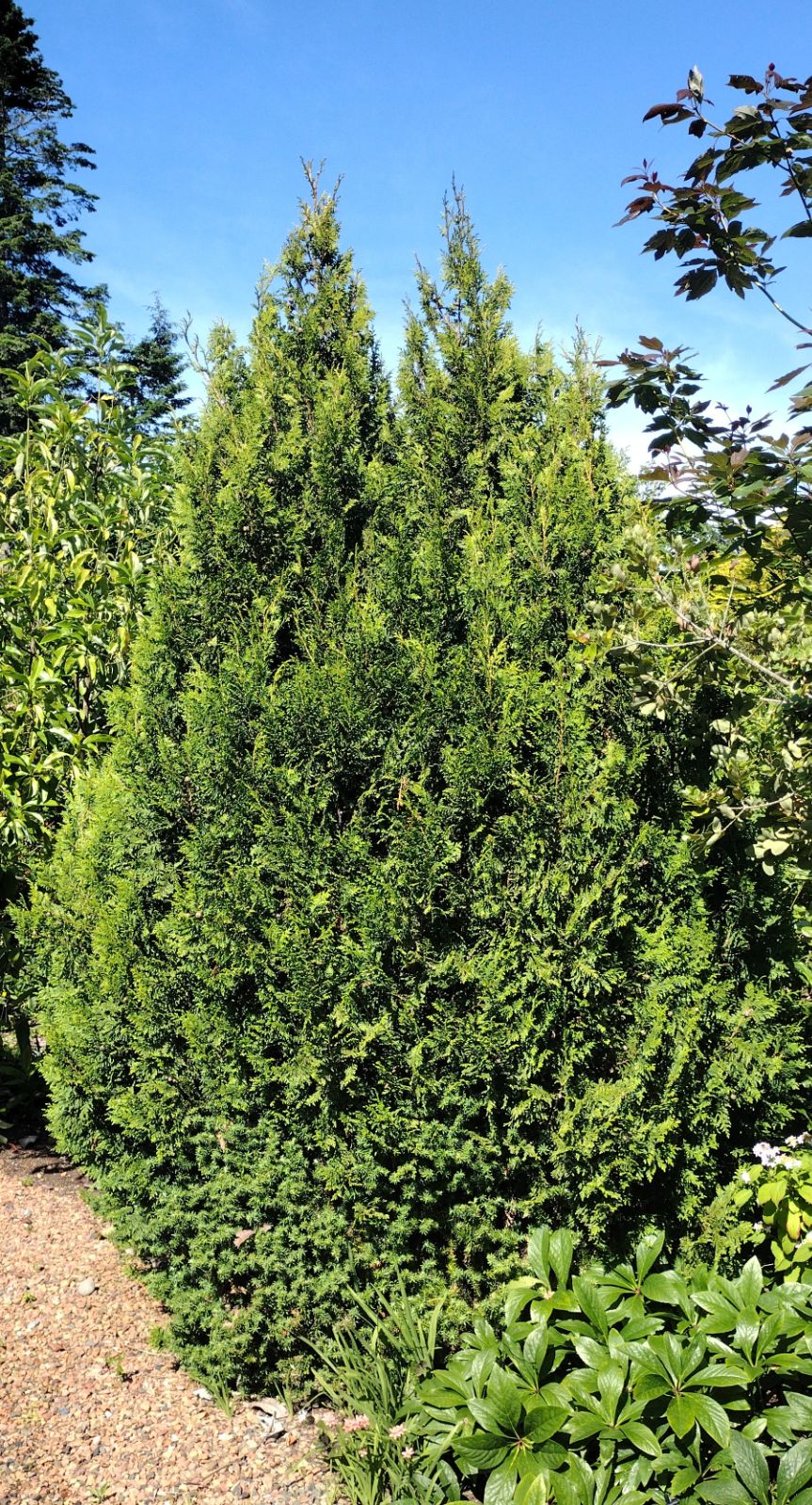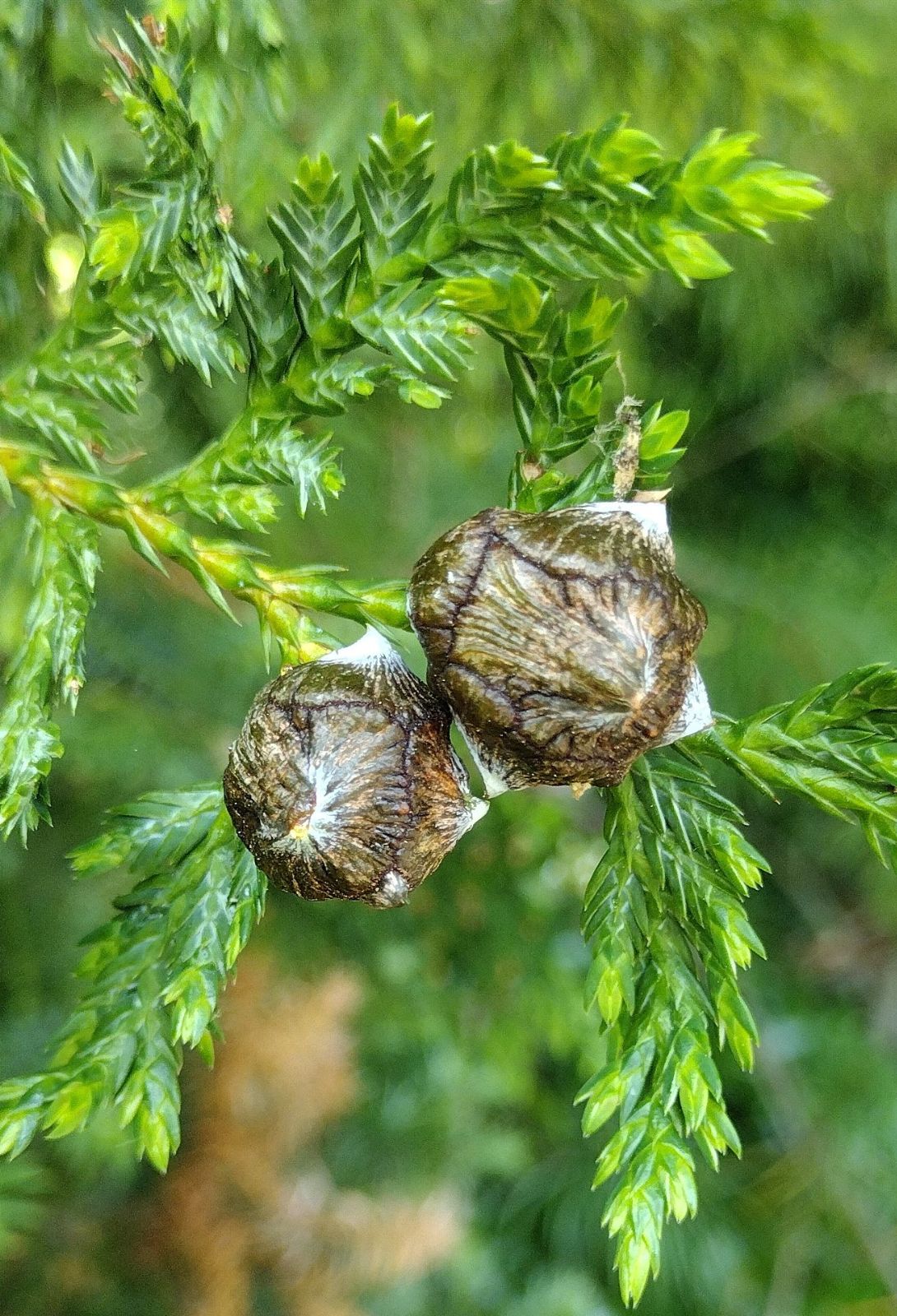Xanthocyparis vietnamensis
Credits
Article from New Trees by John Grimshaw & Ross Bayton
Recommended citation
'Xanthocyparis vietnamensis' from the website Trees and Shrubs Online (treesandshrubsonline.
Genus
Common Names
- Vietnamese Golden-cypress
Synonyms
- Callitropsis vietnamensis (Farjon & Hiep) D.P. Little
- Cupressus vietnamensis (Farjon & Hiep) Q.P. Xiang & J. Li
Tree to 15 m, trunk straight and slender, to 0.5 m dbh. Bark smooth and purplish brown to reddish brown, becoming soft, fibrous and greyish brown in older trees. Crown initially pyramidal, later spreading, irregular or flat-topped. Major branches long, spreading horizontally. Foliage branches numerous and drooping; those with juvenile leaves bushy, not flattened and sparsely branched; those with mature leaves rounded in outline, flattened and with up to four orders of branching. Juvenile leaves green above and with two whitish bands below, arranged in whorls of four, decurrent, monomorphic, free distal section 15–20 × 1.5–2 mm, linear, apex acute; stomata in six to seven rows, within the abaxial whitish bands, parallel to the leaf axis. Mature leaves green, decussate, dimorphic, imbricate, 1.5–3 × 1–1.3 mm, lateral leaf pairs slightly longer than facial leaf pairs, conduplicate, initially decurrent then spreading, margins denticulate, apex acute; facial leaves narrow, ovate-rhombic, keeled, margins minutely denticulate, apex acute or acuminate; stomata inconspicuous, mainly adaxial, covered in wax. Male strobili terminal and solitary, ovoid, 2.5–3.5 × 2–2.5 mm, green to yellowish brown. Seed cones solitary or in groups of two to three, subglobose, 9–11 × 10–12 mm, cone green, ripening to dark brown, persistent after seed dispersal. Seed scales in two (or rarely three) decussate pairs, valvate, outer surface smooth then furrowed, inner surface reddish brown and with faint grey or whitish seed scars, one to three seeds per scale; umbo prominent, 1–2.5 mm long. Seeds eight to nine per cone, reddish brown and ovoid, 4.5–6 × 4–5 mm including wings; seed wings two, lateral, 0.5–1 mm wide, membranous. Farjon et al. 2002, Farjon 2005c. Distribution VIETNAM: Ha Giang (locally in the Bat Dai Son mountain system). Habitat On limestone ridges in montane cloud forest, between 1060 and 1180 m asl. The climate is subtropical, but wet most of the year. Xanthocyparis vietnamensis grows in thin pockets of soil. USDA Hardiness Zone 9 (?). Conservation status Critically Endangered. This species is restricted to only a handful of sites in a 50 km2 area, with an estimated 560 trees, and is prized for its hard, fragrant, yellow-brown timber (IUCN 2007). Illustration Farjon et al. 2002, Cribb 2004, Luu & Thomas 2004, Farjon 2005c; NT902. Taxonomic note Despite the stance of both Farjon and Little that Xanthocyparis is a distinct genus, however interpreted, it is clear that there are several botanists who believe the two species belong in Cupressus, resulting in a regrettable plethora of publications: Cupressus vietnamensis Q.P. Xiang & J. Li (2005), which has priority; C. vietnamensis (Farjon & Hiep) Silba (2005); C. vietnamensis (Farjon & Hiep) Rushforth (2007).
The importance of the discovery of a strange, stunted-looking conifer on a limestone ridge in northern Vietnam, by an expedition in1999 comprising Phillip Cribb, Leonid Averyanov and Nguyen Tien Hiep, was not at first appreciated, and it took a second, unconnected collection in the same year for the species to be recognised as new (Cribb 2004). Its distinctness triggered the creation of the genus Xanthocyparis and the taxonomic dispute that followed. In subsequent years it has been visited in its very limited range by several groups and material has been brought into cultivation. These limestone crags are home to a remarkable diversity of plants, and growing with Xanthocyparis vietnamensis are representatives of up to seven other genera of gymnosperms: Amentotaxus, Nageia, Pinus, Podocarpus, Pseudotsuga, Taxus and Tsuga (Rushforth 2007). Whether the Xanthocyparis is a relict of a cooler climate in the area or truly adapted to a tropical existence is unclear, but this will have great bearing on the chances of its success in cultivation.
In the United Kingdom material collected in 2002 on the Northern Vietnam First Darwin Expedition (nos. 140, 141, 142), and by T.Q. Thao in 2003, grown at the Royal Botanic Garden Edinburgh as part of the International Conifer Conservation Programme, has been passed to a few selected institutions and gardens for safekeeping. When seen in the greenhouses in Edinburgh in 2005 plants were showing the remarkable combination of adult and juvenile foliage for which the species is renowned. Under glass they have grown well, but it is not yet known whether the species will be hardy in our area – or whether its diminutive stature in the wild is a result of its environment or its genes. It is not apparent whether it is currently in cultivation in North America.



